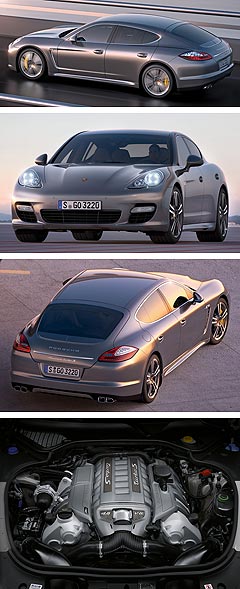First look: Porsche crowns Panamera with Turbo S
BY MARTON PETTENDY | 31st Mar 2011

As we’ve reported, the hybrid Panamera goes on sale here in August with a pricetag that could be as low at $292,000 if Porsche Cars Australia can land it as standard with the low rolling resistance tyres that reduce fuel consumption to less than 7.0L/100km, which would in turn slash the amount of luxury car tax local customers must pay.
Now, PCA has announced an official price of $440,200 for the Panamera Turbo S, which was revealed yesterday in Europe and will top the German sportscar brand’s four-door coupe range here in October.
Representing a whopping $68,000 price premium over the all-wheel drive Panamera Turbo ($372,200) upon which it is based, the Turbo S will be the new Panamera model flagship but in terms of pricing won’t eclipse the 911 Turbo S Cabriolet ($442,800) or the range-topping 911 GT2 RS turbo coupe ($560,000).
Lurking under the Panamera Turbo S bonnet is the most powerful version ever seen of the 4.8-litre petrol V8 that powers the four-seater Panamera and five-seater Cayenne.

To achieve the 10 per cent (or 37kW) power increase over the ‘garden-variety’ (368kW/700Nm) Panamera Turbo – and its most direct rival in the new 386kW/700Nm Mercedes-Benz CLS63 AMG – the S gets the same hardware and software upgrades included in the Panamera’s powerkit, an option box which GoAuto understands is yet to be ticked in Australia.
Specifically, they include revised mapping for the engine control module and the fitment of titanium-aluminium turbine wheels, which Porsche says reduces turbocharger weight and therefore inertia, thereby increasing peak engine power and overall responsiveness.
Using the launch control function of the standard Sport Chrono Package Turbo feature, the Panamera Turbo S is claimed to sprint to 100km/h in a supercar-like 3.8 seconds, making the top-shelf Panamera quicker than the standard Turbo and Porsche’s own 911 GT3 RS (four seconds).
Inexplicably, the optional powerkit is claimed to lower the Panamera Turbo’s 0-100km/h pace to 3.9 seconds, despite the fact the full 800Nm is available in the same Sport and Sport Plus modes, and when the standard seven-speed automatic transmission kicks down in normal mode.
Like the previous-generation Cayenne Turbo S, which was powered by a more highly strung 404kW/750Nm version of Porsche’s superseded twin-turbo 4.8-litre V8, the Panamera Turbo S delivers its extra performance without any increase in fuel consumption over its donor vehicle.
That means that while the much heavier Cayenne Turbo S returned the same 14.9L/100km figure as the standard Cayenne Turbo, the Panamera Turbo S continues to return the same 11.5L/100km (or 11.3L/100km with optional 19-inch low rolling resistance Michelin tyres) as the regular Panamera Turbo.
Apart from extra power, performance and the Sport Chrono Package Turbo with overboost torque function, launch control and a more sporting chassis set-up, the S brings a host of additional standard equipment over the Panamera Turbo, including a sports exhaust system and Servotronic steering, which is said to improve manoeuvrability.
Cosmetically, the Panamera Turbo S is differentiated by 20-inch ‘Turbo II’ wheels that increase the wheel track width at the rear, side skirts from the Porsche Exclusive range and an adaptive extending four-way rear spoiler, while inside there is a bi-colour leather trim finish that is offered in an exclusive new black/cream colour combination, with an ‘agate’ grey/cream colour to come later this year.
Naturally, the S also comes with all of the Panamera Turbo’s standard equipment, including the active anti-roll bars of the Porsche Dynamic Chassis Control (PDCC) system, Porsche Torque Vectoring Plus (PTV Plus), which varies the torque split between the rear wheels in combination with an electronic rear differential.
Beyond this year’s S and Hybrid variants, the Panamera range should be further extended with the addition of diesel and long-wheelbase versions, which are not guaranteed to be sold in Australia.